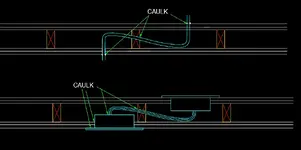C
Cudmasters Los
New member
Installing Audio Cables Through Double Wall near electrical outlet
1) I have electrical outlets in my double wall, (studio has its own power) where audio cables will be passing through. Will this pick up noise, and if so, would incasing the wires work, or what other suggestions do you guys have?
2) I am trying to figure the best way to hook up a headphone signal to the vocal room and the live recording room from the consol room. My room is cut in half in which 1 side is cut 1/4 / 3/4 the 1/4 of coarse being the vocal room. The other side(consol room) I have 2 outputs coming out of my mixer. I would like to have 1 for headphones, but I guess if I used both for each room I could unplug 1 for when I wanted to use the headphones, that would be the easy option. This by the way is with 2 independant headphone amps in each room not including the console room (Mixer). Or could I take 1 output(Mixer) splice the wire and solder the connections to the wallplates that the amps will be connected to in each room? Or what other suggestions do you have.
1) I have electrical outlets in my double wall, (studio has its own power) where audio cables will be passing through. Will this pick up noise, and if so, would incasing the wires work, or what other suggestions do you guys have?
2) I am trying to figure the best way to hook up a headphone signal to the vocal room and the live recording room from the consol room. My room is cut in half in which 1 side is cut 1/4 / 3/4 the 1/4 of coarse being the vocal room. The other side(consol room) I have 2 outputs coming out of my mixer. I would like to have 1 for headphones, but I guess if I used both for each room I could unplug 1 for when I wanted to use the headphones, that would be the easy option. This by the way is with 2 independant headphone amps in each room not including the console room (Mixer). Or could I take 1 output(Mixer) splice the wire and solder the connections to the wallplates that the amps will be connected to in each room? Or what other suggestions do you have.
Last edited:






 No, they don't have to go through studs then(unless local code requires it but if not, use cable straps to fasten to studs), as there are NO seperate wall cavities in the same sense as single walls. The airgap is the same everywhere. However, penetrations through opposing leafs(wall mass such as drywall) should be offset by at least one stud with no rigid contact between these leafs by conduits, pipes etc. Everything should be in flex conduits or bare cables, such as Romex, snakes, Cat 5 etc. Distance and opposing insulation and caulking are the primary deterents to flanking leaks within double walls. But keep in mind, when wires cross from leaf to leaf in a double wall system, they span across an open area between the walls. NORMALLY, single walls have fireblocks between drywall leafs, but double walls do not. Thats why SOME county CODES require insulation to FILL the complete airgap up to 24" high from the floor, which acts as a firestop. I don't know if you had permits and inspection done on these double walls, but I would check with your local building codes or authority to find out if its required in your area. If it were me, I WOULD insulate the complete airgap at least 12" higher than the electrical outlets, just to be safe, as there is NOTHING to stop flames from climbing right up the airgap should a fire start within the wall because of electrical shorts or whatever. But thats me.
No, they don't have to go through studs then(unless local code requires it but if not, use cable straps to fasten to studs), as there are NO seperate wall cavities in the same sense as single walls. The airgap is the same everywhere. However, penetrations through opposing leafs(wall mass such as drywall) should be offset by at least one stud with no rigid contact between these leafs by conduits, pipes etc. Everything should be in flex conduits or bare cables, such as Romex, snakes, Cat 5 etc. Distance and opposing insulation and caulking are the primary deterents to flanking leaks within double walls. But keep in mind, when wires cross from leaf to leaf in a double wall system, they span across an open area between the walls. NORMALLY, single walls have fireblocks between drywall leafs, but double walls do not. Thats why SOME county CODES require insulation to FILL the complete airgap up to 24" high from the floor, which acts as a firestop. I don't know if you had permits and inspection done on these double walls, but I would check with your local building codes or authority to find out if its required in your area. If it were me, I WOULD insulate the complete airgap at least 12" higher than the electrical outlets, just to be safe, as there is NOTHING to stop flames from climbing right up the airgap should a fire start within the wall because of electrical shorts or whatever. But thats me.  Actually, I don't really know. I think these frequencys are too high to affect audio but I could be wrong. I don't personally use it.
Actually, I don't really know. I think these frequencys are too high to affect audio but I could be wrong. I don't personally use it.